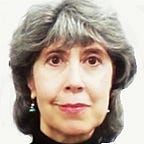FRACTURED: Artist Graupe-Pillard Tackles Environmental Threats
In June of 2023, smoke emanating from over 200 Canadian wildfires created a blanket of air pollution that impacted health and visibility for millions of Americans from the Midwest to the East Coast. It was a real-time sample of what the future could bring.
Artists have been presenting their interpretations of the risks to the planet for decades, back to the original 1970 Earth Day poster by Robert Rauschenberg.
Currently on view at the David Richard Gallery in Chelsea, New York, the exhibit Fractured showcases nine paintings by Grace Graupe-Pillard. It is an uncompromising look at global environmental chaos, which also serves as a metaphor for today’s worldwide instability in the political and social realms.
Graupe-Pillard has built a strong reputation based on her portraiture, digital photography, cut-out canvases, and public art. A humanistic awareness, informed by her personal history, is always at the core of her imagery. The seeds of much of her oeuvre are a commentary on the shortcomings of group behavior.
In the early 2000s, as the drum beat for American boots on the ground in Iraq began, Graupe-Pillard, perceiving falsehoods driving the national agenda, began developing her paintings through a prism of “manipulation and disintegration.” Starting in 2014, she analyzed the event of 9/11 in large-scale paintings entitled “The Day the World Stood Still.” This suite served as a foundation to the experimentation that would embody both pure abstraction and identifiable elements.
Oil Alkyd on Canvas
97” x 67”
2017
In the Fractured series, several pieces skew specifically narrative. Aflame speaks to the out-of-control infernos that have recently besieged America. The most recent, which occurred in Maui, incinerated not only property but also irreplaceable historical artifacts from the Indigenous cultural heritage of Lahaina.
Oil Alkyd on Wood
48” x 36”
2023
In the upper left-hand corner of Green Rush, a tiny part of the expansive universe frames the edge of Earth. Verdant areas of green mix with yellowing terrain, cooled by aquatic shades of blue. Creeping from the right are maroon hues, which give way to crimsons. This deconstruction of our ecosphere, as we know it, will be repeated in unique iterations from painting to painting. When viewed in totality, the interaction creates a palpable existential anxiety about humankind’s ability to wreak destruction.
Oil Alkyd on Canvas
66” x 48”
2023
Water surrounds potential land masses in Vortex. Solid bits of color, perhaps representing terrain, have broken away. For those who are unaware, there are approximately thirteen islands that won’t make it to the end of the 21st century. Rising sea levels will submerge them. American coastal cities are at risk as well.
Oil Alkyd on Canvas
48” x 36”
2023
As war and scenes of physical conflagration fill the daily news feeds with footage from Ukraine and Gaza, it is impossible to ignore the fearsome allegory of Combustion. It confronts the observer with a fireball surrounded by terrestrial browns and offshoots of scorching red, chilled by a spectrum of purples to grays. The map-like forms yield the option to consider how the ultimate form of an environmental disaster — nuclear destruction — could potentially be triggered.
Oil Alkyd on Canvas
84” x 60”
2020
I reached out to Graupe-Pillard to discuss her process and get insights on how she perceives the artist’s role in today’s culture.
She walked me through a progression that begins when she culls source material from climate catastrophes, using the computer as a “collaborator” to create new digital forms. After she has established her vision, she begins to paint. Graupe-Pillard referenced her approach as parallel to what she sees as the media’s “filtering of information” to the public. She stated, “As an artist, I document what is occurring in the world. Some will respond to the work visually and in a purely formal way. Others will consider the context of my intent and reflect upon issues they may not have previously thought about — specifically the[environmental] dangers that face us.”
Graupe-Pillard delivered the cautionary note, “The paintings are a precursor to a devastating scenario if individuals remain uninvolved.”
All photos: Courtesy of David Richard Gallery
© Grace Graupe-Pillard
David Richard Gallery
508 West 26th Street, Suite 9F
Through February 8
Wed-Sat 11:00 am-6:00 pm or by appointment
